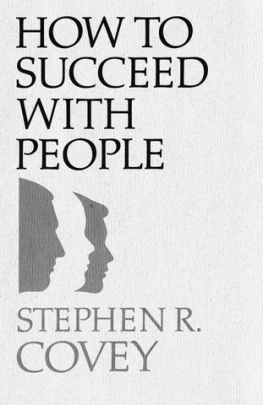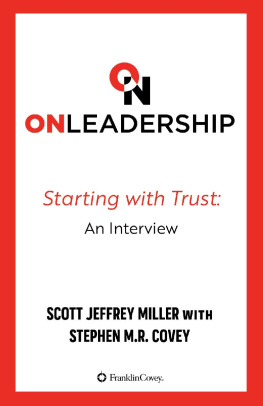
Copyright 2018 Stephen R. Covey.
Published by Mango Publishing Group, a division of Mango Media Inc.
Mango is an active supporter of authors rights to free speech and artistic expression in their books. The purpose of copyright is to encourage authors to produce exceptional works that enrich our culture and our open society.
Uploading or distributing photos, scans or any content from this book without prior permission is theft of the authors intellectual property. Please honor the authors work as you would your own. Thank you in advance for respecting our authors rights.
For permission requests, please contact the publisher at:
Mango Publishing Group
2850 Douglas Road, 3rd Floor
Coral Gables, FL 33134 USA
info@mango.bz
For special orders, quantity sales, course adoptions and corporate sales, please email the publisher at sales@mango.bz. For trade and wholesale sales, please contact Ingram Publisher Services at customer.service@ingramcontent.com or +1.800.509.4887.
Execution Essentials: Disciplines to Execute with Excellence
ISBN: (ebook) 978-1-63353-911-2
Printed in the United States of America
Foreword
Why do most major organizational initiatives fizzle out or fall well short of original expectations? Its not primarily because those initiatives arent well thought out. Usually, its because of a lack of great execution.
FranklinCovey has approached the topic of great execution at a perhaps unprecedented level. We have studied what gets in the wayfrom the boardroom to the front lineand isolated the factors that are necessary for precise execution. In the process, we have:
- Worked deep within more than 400 organizations of all types, helping them ensure that key initiatives actually get implemented.
- Analyzed the data from more than 200,000 surveys at all organizational levels regarding execution practices.
- Conducted interviews around execution practices with members of more than 1,000 teams.
The result? We have learned how organizations execute with excellence. We have seen:
- A major information-technology services company increase revenues by nearly $1 billion.
- A retail-store chain rise from worst to first in their market.
- A media company go from decline to rebirth as a media powerhouse.
- The government of an American state achieve a dramatic increase in customer-satisfaction scores.
Most important, we have seen hundreds of organizations actually fulfill their own great purposes. At FranklinCovey, we are dedicated to enabling greatness in organizations and individuals everywhere. Nothing is more vital to us than this mission.
Execution Essentials provides you an easy-to-read, easily referenced guide to some of the things we at FranklinCovey have learned about executing with excellence. It also includes world-class thinking from the best minds on the subject of execution. Get to know this book. Carry it with you. I know it will help you achieve your most important goals.
Bob Whitman
Chairman of the Board and CEO
FranklinCovey
Chapter 1
Understanding the Execution Gap
Ultimately, what are you responsible for?
Results.
Results are affected by things you can control and things you cant control. There are two things you can control:
- The plan (i.e., what you want to accomplish)
- The execution of the plan (how you are going to accomplish it)
In your experience, which of these two things do you struggle more withthe plan, or the execution of the plan?
Isnt it almost always the execution of the plan?
Kevin Rollins, CEO of Dell Computers, put it this way: If you look at companies that have done really well out there, they have great strategies, but they are maniacal implementers.
We too often underestimate the difficulty of execution.
Whenever a new goal is set, someone somewhere must do something theyve never done before; and until they do that, there is no execution. They must change their behavior.
And changing behavior is perhaps the hardest thing we ever dowhich goes a long way toward explaining why most organizations suffer from an execution gap.
What Is the Execution Gap?
A major study of public companies found that only 13 percent of them were able to consistently meet their stated financial goals over the decade of the 1990sone of the most prosperous decades for business in history. And according to one estimate, 7 out of 10 strategic initiatives eventually fail.
So an organization can have talented people and a superb strategy and still fail. And many do. The reason? Its rarely for a lack of smarts or vision. Its bad execution. As simple as that: not getting things done, being indecisive, not delivering on commitments, says former Harvard Business School Professor Ram Charan.
He says, The greatest unaddressed issue in the business world today is the execution gapthe gap between setting a goal and achieving it.
The 4 Breakdowns in Execution
There are four reasons for the execution gap:
- People dont know the goal.
- People dont know what to do to achieve the goal.
- People dont keep score.
- People are not held accountable for progress on the goal.
These findings come from a joint xQ Survey of 12,000 U.S. workers conducted by FranklinCovey and HarrisInteractive in December 2003 .
So an organization can have talented people and a superb strategy and still fail. And many do. The reason? Its rarely for a lack of smarts or vision. Its bad execution. As simple as that: not getting things done, being indecisive, not delivering on commitments, says former Harvard Business School Professor Ram Charan.
He says, The greatest unaddressed issue in the business world today is the execution gapthe gap between setting a goal and achieving it.
People dont know the goal.
Although 49 percent of workers say they know the goals of the organization they work for, only about 15 percent can actually tell you what those goals are. Obviously, if only one in six workers knows the goal, execution is at serious risk.
People dont know what to do to achieve the goal.
When asked if this statement is true: I clearly understand what Im supposed to do to help achieve my organizations goals, only 54 percent of the respondents say yes. This means that nearly half of all workers report candidly that they dont know what to doand the other half might be fooling themselves.
People dont keep score.
Only about 12 percent of workers can tell you how success is measured on the goals of their organization. Unless the people who do the work know the score, how can they tell if they are winning or not? And how can they course-correct if the score is going wrong?
People are not held accountable for progress on the goal.
Only 26 percent of workers meet even monthly with their manager to review progress on goals. This means that three out of four workers have little or no dialogue with management about the goals they are responsible for.
Why are these indicators so low?
From the viewpoint of leadership, the goals are often completely clear and the strategy utterly compelling.
Leaders host a big roll-out event to announce the strategic goal. Its brilliantly presented and everyone stands and cheers. If youre a leader, its your best moment.
Its also the moment of truth. About half the people in the room actually hear the goal, and only about half of those people know what to do about the goal. Furthermore, only about half of those people actually do anything about the goaland many of them dont care one way or the other.
Next page
















